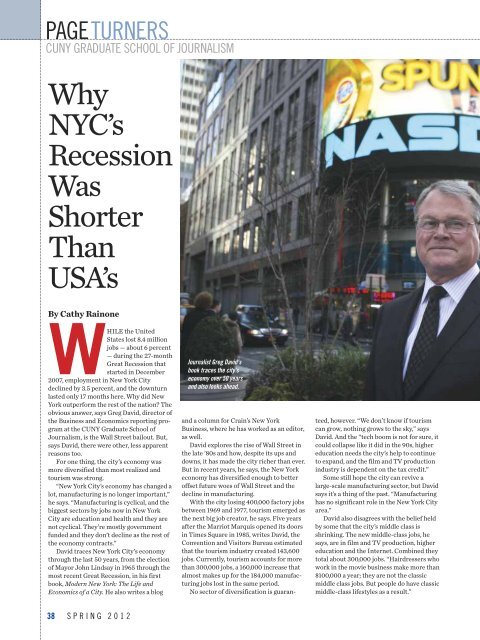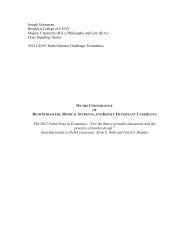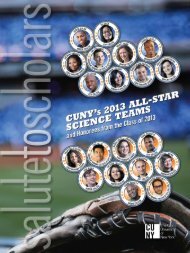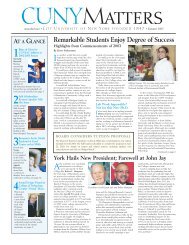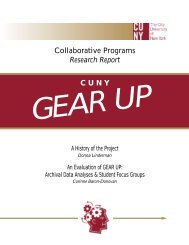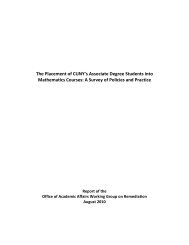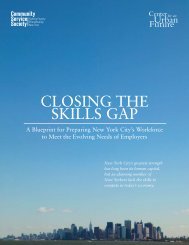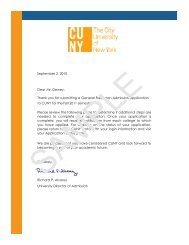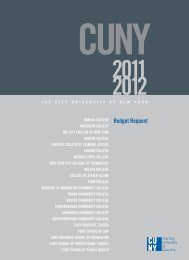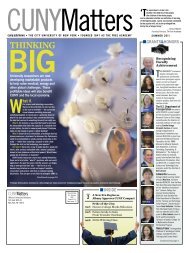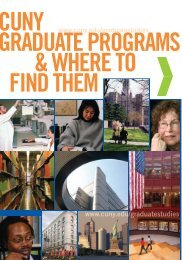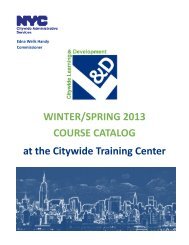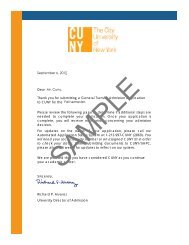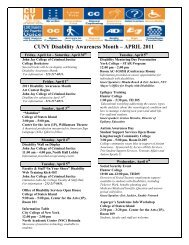Reform and Rigor in CUNY's Common Core
Reform and Rigor in CUNY's Common Core
Reform and Rigor in CUNY's Common Core
You also want an ePaper? Increase the reach of your titles
YUMPU automatically turns print PDFs into web optimized ePapers that Google loves.
PAGETURNERS<br />
CUNY GRADUATE SCHOOL OF JOURNALISM<br />
Why<br />
NYC’s<br />
Recession<br />
Was<br />
Shorter<br />
Than<br />
USA’s<br />
By Cathy Ra<strong>in</strong>one<br />
WHILE the United<br />
States lost 8.4 million<br />
jobs — about 6 percent<br />
— dur<strong>in</strong>g the 27-month<br />
Great Recession that<br />
started <strong>in</strong> December<br />
2007, employment <strong>in</strong> New York City<br />
decl<strong>in</strong>ed by 3.5 percent, <strong>and</strong> the downturn<br />
lasted only 17 months here. Why did New<br />
York outperform the rest of the nation? The<br />
obvious answer, says Greg David, director of<br />
the Bus<strong>in</strong>ess <strong>and</strong> Economics report<strong>in</strong>g program<br />
at the CUNY Graduate School of<br />
Journalism, is the Wall Street bailout. But,<br />
says David, there were other, less apparent<br />
reasons too.<br />
For one th<strong>in</strong>g, the city’s economy was<br />
more diversified than most realized <strong>and</strong><br />
tourism was strong.<br />
“New York City’s economy has changed a<br />
lot, manufactur<strong>in</strong>g is no longer important,”<br />
he says. “Manufactur<strong>in</strong>g is cyclical, <strong>and</strong> the<br />
biggest sectors by jobs now <strong>in</strong> New York<br />
City are education <strong>and</strong> health <strong>and</strong> they are<br />
not cyclical. They’re mostly government<br />
funded <strong>and</strong> they don’t decl<strong>in</strong>e as the rest of<br />
the economy contracts.”<br />
David traces New York City’s economy<br />
through the last 50 years, from the election<br />
of Mayor John L<strong>in</strong>dsay <strong>in</strong> 1965 through the<br />
most recent Great Recession, <strong>in</strong> his first<br />
book, Modern New York: The Life <strong>and</strong><br />
Economics of a City. He also writes a blog<br />
Journalist Greg David's<br />
book traces the city's<br />
economy over 50 years<br />
<strong>and</strong> also looks ahead.<br />
<strong>and</strong> a column for Cra<strong>in</strong>’s New York<br />
Bus<strong>in</strong>ess, where he has worked as an editor,<br />
as well.<br />
David explores the rise of Wall Street <strong>in</strong><br />
the late ’80s <strong>and</strong> how, despite its ups <strong>and</strong><br />
downs, it has made the city richer than ever.<br />
But <strong>in</strong> recent years, he says, the New York<br />
economy has diversified enough to better<br />
offset future woes of Wall Street <strong>and</strong> the<br />
decl<strong>in</strong>e <strong>in</strong> manufactur<strong>in</strong>g.<br />
With the city los<strong>in</strong>g 400,000 factory jobs<br />
between 1969 <strong>and</strong> 1977, tourism emerged as<br />
the next big job creator, he says. Five years<br />
after the Marriot Marquis opened its doors<br />
<strong>in</strong> Times Square <strong>in</strong> 1985, writes David, the<br />
Convention <strong>and</strong> Visitors Bureau estimated<br />
that the tourism <strong>in</strong>dustry created 143,600<br />
jobs. Currently, tourism accounts for more<br />
than 300,000 jobs, a 160,000 <strong>in</strong>crease that<br />
almost makes up for the 184,000 manufactur<strong>in</strong>g<br />
jobs lost <strong>in</strong> the same period.<br />
No sector of diversification is guaranteed,<br />
however. “We don’t know if tourism<br />
can grow, noth<strong>in</strong>g grows to the sky,” says<br />
David. And the “tech boom is not for sure, it<br />
could collapse like it did <strong>in</strong> the 90s, higher<br />
education needs the city’s help to cont<strong>in</strong>ue<br />
to exp<strong>and</strong>, <strong>and</strong> the film <strong>and</strong> TV production<br />
<strong>in</strong>dustry is dependent on the tax credit.”<br />
Some still hope the city can revive a<br />
large-scale manufactur<strong>in</strong>g sector, but David<br />
says it’s a th<strong>in</strong>g of the past. “Manufactur<strong>in</strong>g<br />
has no significant role <strong>in</strong> the New York City<br />
area.”<br />
David also disagrees with the belief held<br />
by some that the city’s middle class is<br />
shr<strong>in</strong>k<strong>in</strong>g. The new middle-class jobs, he<br />
says, are <strong>in</strong> film <strong>and</strong> TV production, higher<br />
education <strong>and</strong> the Internet. Comb<strong>in</strong>ed they<br />
total about 300,000 jobs. “Hairdressers who<br />
work <strong>in</strong> the movie bus<strong>in</strong>ess make more than<br />
$100,000 a year; they are not the classic<br />
middle class jobs. But people do have classic<br />
middle-class lifestyles as a result.”<br />
38 SPRING 2012


